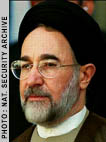Documents reveal Bill Clinton’s secret contact with Iran
May 31, 2010 Leave a comment

M. Khatami
By IAN ALLEN | intelNews.org |
Two newly declassified high-level documents reveal a short-lived overture between Washington and Tehran, initiated in 1999 by the Bill Clinton administration. The US President resorted to the secret communication with Iran in an attempt to preempt several hawkish policy planners in his administration. The latter pressed for strong American military retaliation against Iran, in response to the latter’s alleged involvement in the 1996 Khobar Towers bombing. The bombing, which targeted a US Air Force base in the suburbs of Dhahran, Saudi Arabia, killed 19 and wounded 400 American servicemen and women. By 1999, US intelligence agencies were convinced that the bombing had been financed and orchestrated by members of the Islamic Revolutionary Guards Corps (IRGC), an independent administrative and paramilitary institution tasked with –among other things– exporting the Iranian Revolution abroad. But the Clinton Administration decided to contact the then newly elected reformist Iranian President Mohammad Khatami, and sternly inform him of the evidence against the IRGC. This was done through a personal letter from President Clinton to President Khatami, which was apparently hand-delivered to the Iranian leader via Sultan Qaboos bin Said al Said of Oman. In the top-secret letter, which has now been declassified through a Freedom of Information Act request by George Washington University’s National Security Archive, the US President sternly warned the Iranian leader that the US had “direct evidence” linking the IRGC to the Khobar Towers bombing. He went on to demand that the Iranian government extradited to either the US or Saudi Arabia those IRGC members responsible for the attack. But the US President and his advisers appear to have been unaware that the reformist Khatami would share Washington’s letter with senior members of the –far from reformist– Iranian leadership, including Supreme Leader Ali Khamenei, who were incensed by the US demands. Tehran then drafted a letter, which, although it included “language that seem[ed] to leave the door open for future approaches”, was interpreted by Washington to signify that Iran had no interest in rapprochement. The White House then proceeded to immediately terminate the Omani backchannel. Interestingly, however, it chose not to proceed with military retaliation against Iran, so as not to alienate the reformist leadership of President Khatami, who had no links to the Khobar Towers bombing. The declassified letters are available on the National Security Archive’s website, located here.






